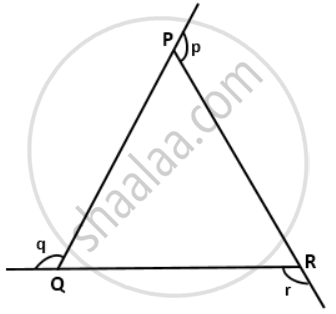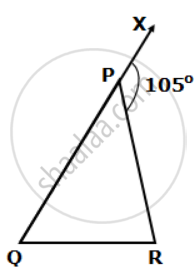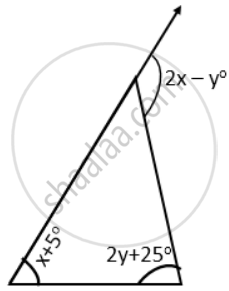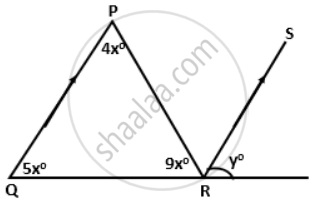Advertisements
Advertisements
प्रश्न
Use the given figure to show that: ∠p + ∠q + ∠r = 360°.
उत्तर
By exterior angle property,
∠p = ∠PQR + ∠PRQ
∠q = ∠QPR + ∠PRQ
∠r = ∠PQr + ∠QPR
Now, ∠p + ∠q + ∠r
= ∠PQR + ∠PRQ + ∠QPR + ∠PRQ + ∠PQR + ∠QPR
⇒ ∠p + ∠q + ∠r = 2∠PQR + ∠2PRQ + 2∠QPR
⇒ ∠p + ∠q + ∠r = 2(∠PQR + ∠2PRQ + 2∠QPR)
⇒ ∠p + ∠q + ∠r = 2 x 180° ....[Angle sum property: ∠PQR + ∠PRQ + ∠QPR = 180°]
⇒ ∠p + ∠q + ∠r = 360°.
APPEARS IN
संबंधित प्रश्न
In the given figure, ∠Q: ∠R = 1: 2. Find:
a. ∠Q
b. ∠R
Use the given figure to find the value of x in terms of y. Calculate x, if y = 15°.
In a triangle PQR, ∠P + ∠Q = 130° and ∠P + ∠R = 120°. Calculate each angle of the triangle.
In the figure given below, if RS is parallel to PQ, then find the value of ∠y.
In a triangle PQR, the internal bisectors of angles Q and R meet at A and the external bisectors of the angles Q and R meet at B. Prove that: ∠QAR + ∠QBR = 180°.
In a triangle ABC. If D is a point on BC such that ∠CAD = ∠B, then prove that: ∠ADC = ∠BAC.
In a triangle ABC, if the bisectors of angles ABC and ACB meet at M then prove that: ∠BMC = 90° + `(1)/(2)` ∠A.
If bisectors of angles A and D of a quadrilateral ABCD meet at 0, then show that ∠B + ∠C = 2 ∠AOD
If each angle of a triangle is less than the sum of the other two angles of it; prove that the triangle is acute-angled.
In a triangle, the sum of two angles is 139° and their difference is 5°; find each angle of the triangle.
